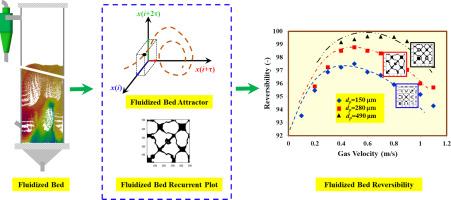Reversibility and entropy in bubbling fluidized beds: A recurrence-based analysis
IF 4.6
2区 工程技术
Q2 ENGINEERING, CHEMICAL
引用次数: 0
Abstract
Nonlinear time series analysis techniques were applied to characterize bubbling fluidization. The delay method was used to reconstruct the state space attractor and analyze the reconstructed state space. The experiments were carried out in a laboratory-scale fluidized bed, operated under ambient conditions and with various sizes of particles, settled bed heights, measurement heights, and superficial gas velocities. The reversibility of the gas-solid fluidized bed hydrodynamics was investigated using pressure fluctuations by recurrence plot analysis. The anti-diagonal lines of the recurrence plot (RP) were regarded as a measure of reversibility. It was shown that the reversibility versus gas velocity has a concave shape in the bubbling regime. The highest reversibility occurs at velocities remarkably lower than the turbulent transition velocity. In addition, reversibility increases as the size of the particles increases. The Kolmogorov entropy was also estimated to confirm the reversibility analysis in the state space domain. In addition, the average cycle frequency and wideband energy in the frequency domain were also used to clarify the results in the state domain. It was found that a minimum in average cycle frequency, wideband energy, and entropy with an increase in the velocity corresponds to the transition between macrostructures and finer structures of the fluidization system. This minimum was primarily found in the macrostructures of the bubbling fluidization system. These findings can provide a practical tool for the optimal design and operation of the fluidized bed.

鼓泡流化床的可逆性和熵:一个基于递归的分析
采用非线性时间序列分析技术对鼓泡流化过程进行了表征。利用延迟法对状态空间吸引子进行重构,并对重构后的状态空间进行分析。实验是在实验室规模的流化床中进行的,在环境条件下运行,并具有不同尺寸的颗粒,沉降床高度,测量高度和表面气速。采用压力波动递归图分析方法研究了气固流化床流体力学的可逆性。递归图(RP)的反对角线被认为是可逆性的度量。结果表明,在鼓泡状态下,可逆性与气速的关系呈凹形。最高可逆性发生在明显低于湍流过渡速度的速度下。此外,可逆性随着颗粒尺寸的增大而增大。估计了Kolmogorov熵以证实状态空间域的可逆性分析。此外,还利用频域的平均周期频率和宽带能量来澄清状态域的结果。研究发现,平均循环频率、宽带能量和熵值随流速的增加而减小,这与流化系统的宏观结构和精细结构之间的过渡相对应。这个最小值主要出现在鼓泡流化系统的宏观结构中。这些研究结果可为流化床的优化设计和运行提供实用工具。
本文章由计算机程序翻译,如有差异,请以英文原文为准。
求助全文
约1分钟内获得全文
求助全文
来源期刊

Powder Technology
工程技术-工程:化工
CiteScore
9.90
自引率
15.40%
发文量
1047
审稿时长
46 days
期刊介绍:
Powder Technology is an International Journal on the Science and Technology of Wet and Dry Particulate Systems. Powder Technology publishes papers on all aspects of the formation of particles and their characterisation and on the study of systems containing particulate solids. No limitation is imposed on the size of the particles, which may range from nanometre scale, as in pigments or aerosols, to that of mined or quarried materials. The following list of topics is not intended to be comprehensive, but rather to indicate typical subjects which fall within the scope of the journal's interests:
Formation and synthesis of particles by precipitation and other methods.
Modification of particles by agglomeration, coating, comminution and attrition.
Characterisation of the size, shape, surface area, pore structure and strength of particles and agglomerates (including the origins and effects of inter particle forces).
Packing, failure, flow and permeability of assemblies of particles.
Particle-particle interactions and suspension rheology.
Handling and processing operations such as slurry flow, fluidization, pneumatic conveying.
Interactions between particles and their environment, including delivery of particulate products to the body.
Applications of particle technology in production of pharmaceuticals, chemicals, foods, pigments, structural, and functional materials and in environmental and energy related matters.
For materials-oriented contributions we are looking for articles revealing the effect of particle/powder characteristics (size, morphology and composition, in that order) on material performance or functionality and, ideally, comparison to any industrial standard.
 求助内容:
求助内容: 应助结果提醒方式:
应助结果提醒方式:


